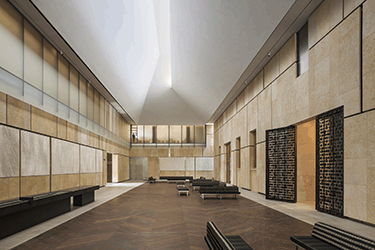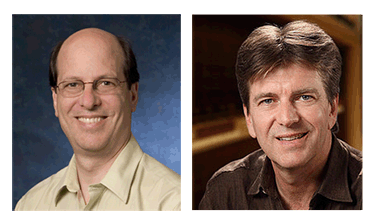When news first surfaced back in late May that AV industry consultancy Acoustic Dimensions was splitting its offices into two rebranded firms, curious minds wondered what kind of backstory lead up to this seemingly surprising development.
L to R: Acoustic Distinction's Ron Eligator; Idibri's Craig Janssen.
In anticipation of SCN’s first annual Consultant Guide issue (due out in September) we've talked to leaders of both organizations to see how the new identities came about and what it says about the industry—past, present, and future.
After speaking with Ron Eligator, one of the principals at New York-based Acoustic Distinctions, and Craig Janssen, managing director of Idibri, headquartered in Dallas, not only was it apparent that the firms have been independent of each other for years and the official rebranding was a natural progression, but also, the path that each of them have come to be on is a far more compelling story than the minutia behind their split.
In brief, the three New York area offices have always been independent from their counterparts in Dallas and San Diego, the latter of which make up Idibri (pronounced eye-dee-bree), along with a UK office. They essentially operated under the branding of a third company, which they mutually decided to dissolve this year, Janssen explained.
The 20-plus years of partnership coincided with the tremendous changes the AV industry has undergone. “Our firms have grown in different ways,” Eligator said. “We felt it was appropriate for us to take the initiative to go off and be able to grow [each of] our businesses in the direction they were more focused on.” He described the decision as collaborative. “It has come about after many years of a very productive partnership.”
Acoustic Distinctions
For Eligator, the last 20 years in the AV industry have yielded “a much greater emphasis on integration of design through the industry.” It’s this perception of “the industry” that has taken on new meaning. It’s no longer the audio visual industry; “the industry,” as AV professionals traditionally know it as is now inclusive of IT, security, control, etc., which Eligator places under the umbrella of low voltage systems.

Barnes Atrium is the Barnes Foundation Museum in Philadelphia, PA. Photo credit: Tom Crane 2012.
Mike Umile, a consultant at Acoustic Distinctions, went on to describe what some of the effects of this dynamic are as he’s noticed working on the ground level. “The audio video side of things is really becoming faster, leaner, more efficient, and there’s a decent amount of rapid prototyping [that] is required of us on these projects.”
As a result, he’s seen many jobs being fast tracked where decisions are made in a day or two in what used to take a week. This requires them to be more agile and stay on top of a lot more technology now. “As more of our signal types are carried on the same infrastructure that IT has been installing for decades, we have to expand our knowledge and skills into these other markets. It has to become quicker, and more integration is required to make sure that we are playing nicely with the IT department.”
The Acoustic Distinctions team is required to talk more to the overall building engineers now, and in turn, Umile said, “we’re seeing much more integration of our technology into the overall concept of equipment in the facility.”
Umile has also observed that this consolidation of the trades extends to the contract holders. “More and more, we’re seeing one trade taking multiple contracts. An IT firm might buy the AV contract where they may still subcontract an AV firm, “but they’ll still hold that AV contract,” he said. “A lot of times we’ll see the electrical contractor take both those contracts on.”
While many in the industry have responded to these changes with disgruntlement and discouragement, Acoustic Distinctions sees it simply as something that they have to adapt to. When they see contracts consolidated as such, the key is to get on board and speak to the contract holders ASAP. “When we work with them before they are even in the field, we’ve had really good results in those situations,” Umile said.
A big place where this converged type of integration has become really critical is in performing arts centers and higher education applications, two of Acoustic Distinctions strongest areas. Currently they are working on projects with the State University of New York network, Hamilton College, and the University of Wyoming. AV is a critical factor for success in these projects, Eligator said. They work on how the systems are being used currently and project how they will be used in 10 or 20 years for future proofing. Issues of sustainable design play in here, along with the need for controlling energy costs. “We start with understanding program requirements today, how best to integrate that into a coherent design that is cost effective and practical for these universities going forward,” Eligator said.
Acoustic Distinctions has also recently worked on a number of large cultural buildings and museums, like the Barnes Foundation of Philadelphia, which “incorporates a lot of technology infrastructure that is expandable and flexible for future changes, as well as traditional sustainable design practices in terms of energy efficiency and environmental control for these very sensitive artworks going forward,” he said.
“Really it’s all about creating infrastructure that will be flexible enough to accommodate whatever changes will come ahead.”
The search for creative financing is a trend Eligator has observed with clients trying to build projects on a low budget due to financial restraints. Contracts might be divided into pieces, making the administration and the quality control more difficult. Trying to explain the consequences of these decisions is one strategy he said they employ.
In terms of financial restraints, many projects that were put on hold for years are starting to come up now, but many clients are reducing the projects into smaller, “bite-sized chunks,” that are more reasonable to budget and fund. During the concept design phase, Eligator said they decide how to split a project up, and they might have to shelf a piece of it or phase projects out over a few years. This is especially true in corporate office facility projects.
Financial institutions—and corporate facilities in general—are one of the strongest areas of growth for Acoustic Distinctions right now, in addition to “a comeback you might say over the last several years in education markets,” Eligator said. “Overall it seems that the economy is picking up. There’s a lot of work out there as far as we can see in many of these different industries.”
Idibri
So, "what’s in the name?" seems like the obvious first question for Idibri.
“We wanted to find a name that would describe who we were rather than what we did,” Janssen explained. “Too many names in the industry are prescriptive. We didn’t want that.”

CenturyLink Center Omaha. Photo credit: MECA.
They knew they wanted a one-word name to make it simple and clean while relating to the work they do. The team behind the rebranding decided they needed to be lighthearted and have fun while being casual too. The result was a play on the concept of “bright ideas.” Thus Idibri was born.
“I think the AV market is a misnomer,” Janssen declared, without a second of hesitation when asked about he changing AV market. “I think the challenge with the industry is that we segment it into these nice clean buckets, and it’s not that clean cut anymore.”
Some people talk about lighting or acoustics as a different industry, but they’re not because all of these markets are converging (or have already converged, depending on your perspective).
Nearly all of the consulting practices of any scale have converged, he said, adding that most of the larger practices have multiple disciplines within their group.
“Where is it going? I think everything connects to everything. If you don’t have your finger on all of those connections, you’re going to get left behind. You’re either in the game or out of it.”
The Idibri brand is boldly addressing these issues Janssen asserted.
Performing arts centers, entertainment venues, sports facilities, houses of worship, education, and larger corporate buildings are the verticals Idibri is most active with. “When there’s a stage and an audience, we seem to instinctively do those well,” he said. “Maybe because everyone in our company comes from some type of entertainment or theater background. It comes down to passion.”
Janssen shared some interesting observations he’s made about the market. One state in particular that he has been impressed by its strong growth recently has been California, which he said, “has come alive very strongly in the last year and a half. Two to three years ago, California was just dead—just horribly so. But the last 18 months, it has exploded in the amount of work.”
Business for Idibri in Texas and the Midwest has been static, but decent, he reported. The firm is starting to see more out of the eastern United States, which typically it did not market much toward because of its New York office, but that is changing. Work in the Far East has been very strong, and Idibri has several current projects in the Middle East.
In terms of vertical markets, large corporate projects seem to be a big strength currently. Janssen has seen an uptick in entertainment venues. Having won some really large projects in that area recently, he noted, “I think some of our competitors have too.” He is also seeing a lot of money being spent in the hospitality market.
One interesting project for Idibri is at the Harvard School of Business, where they’re working on a new venue, which he said was fascinating because of, “the way they want to use technology to reach out,” and “the way they want to leverage technology is really exciting. We’re really enjoying working with them, and will see where it will go.”
Multiple churches are on the docket at the moment, including a full-scale rock n’ roll church in Ireland. Other specific projects include renovations to the Buffalo Bills’ stadium, opening in August with a whole new video broadcast system and main LED boards, among other features. A new football stadium at Baylor University is also opening in August.
To wrap up the Idibri story, Janssen plugged InfoComm, for which he serves on the board. He commented that the association is much bigger in the marketplace than most people realize, thus is their influence—something he has come to realize as he has become more heavily involved.
“As an industry, we have the opportunity to work together as an industry to forge the future or to be passive and overrun.”

